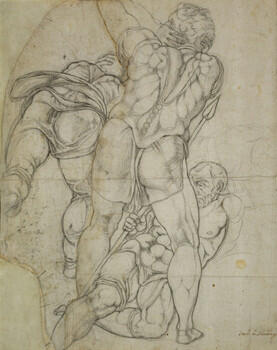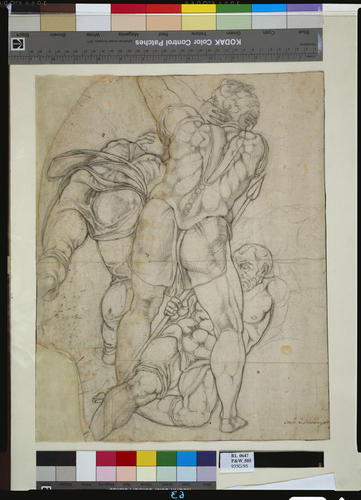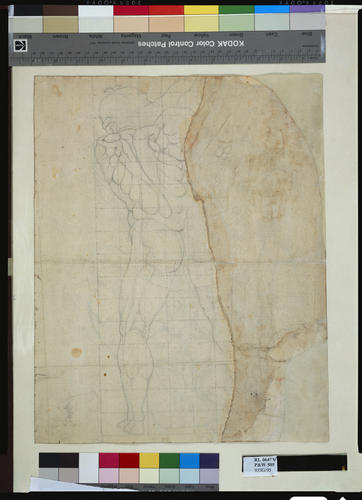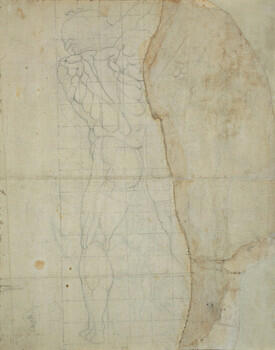-
1 of 253523 objects
Three soldiers, from Michelangelo's Conversion of St Paul c.1560
Black chalk; watermark of a blacksmith. | 41.2 x 32.9 cm (sheet of paper) | RCIN 990647

After Michelangelo Buonarroti (Caprese 1475-Rome 1564)
Three soldiers, from Michelangelo's Conversion of St Paul c.1560

After Michelangelo Buonarroti (Caprese 1475-Rome 1564)
Three soldiers, from Michelangelo's Conversion of St Paul c.1560

After Michelangelo Buonarroti (Caprese 1475-Rome 1564)
Three soldiers, from Michelangelo's Conversion of St Paul c.1560




-
A black chalk drawing of three soldiers from Michelangelo’s Conversion of Saint Paul in the Pauline Chapel, Vatican Palace, executed between November 1542 and July 1545.
The drawing is composed of three irregular pieces of paper (two large, sihouetted along the principal figure, and one small, attached with sealing wax), suggesting that the copy was made under difficult conditions, probably before the fresco itself, and not from an intermediate copy. The same is true of its companion (RCIN 991362, by the same artist and with the same inscription), which is made up of four pieces of paper, again irregularly cut. The difficulties of copying a large fresco situated in a narrow space were considerable. Given the size of the present drawing and 991362, a complete copy would have been very large and may have been aimed at producing a painted version or, conceivably, a large engraving, perhaps in sections, like some of those made after the Last Judgment. However, the treatment seems unusually broad to be the basis of an engraving.
The draftsman seems to have adopted the procedure of copying a section of the fresco and then, perhaps when he encountered difficulties, cutting his sheet and joining another to it, on which the forms begun on the first were continued. In the present copy, the recto of the right-hand fragment of this composite sheet, which was drawn first, contains the standing soldier clasping his ears and another soldier sprawled beneath him. The outlines of the standing figure, but not of the sprawled one, were then traced through to the verso and squared. The reason for this can only be conjectured. The draftsman then silhouetted the left-hand edge of the standing soldier and added a separate piece of paper on which he drew the figure of the fleeing soldier. The left-hand side of this section was cut to a curve, perhaps to fit with a further section.
The fleeing soldier is more fluently executed than the main figure, and this might suggest that the copy is collaborative. But since no sich qualitative discrepancies can be detected in the companion drawing, this possibility should probably be dismissed. Nevertheless, the draftsman was clearly capable of vivacity, even if in only a part of his drawing. The way in which that figure is executed, with softer shadows and more emphatic realisation of the drapery folds than in the standing soldier, is reminiscent of the painterly manner in some of the chalk drawings of Taddeo Zuccaro. A drawing for the Frangipani Chapel in San Marcello al Corso in Rome, begun c.1558 (Uffizi, Florence, inv. 13598F), although in red chalk rather than black chalk, shows distinct similarities. In fact, Michelangelo’s fleeing soldier was of particular interest to Taddeo, who produced a magnificent variant upon it in a drawing now in the National Gallery of Art, Washington, and it may be that the present drawing was made in Taddeo’s circle: he seems to have had numerous assistants, but little is known about them.
Inscribed in pen and ink, lower right, in a hand of the eighteenth century, ‘Studi di Michelangelo’. On the verso, the main figure traced in outline and squared.
Text adapted from P. Joannides, Michelangelo and his Influence. Drawings from Windsor Castle, London 1996, no. 63.Provenance
Possibly one of the two drawings listed in George III's Inventory A, c.1800, p. 44, 'Mich: Angelo Buonarroti’, Tom. I: ‘54. & 55. Other Figures of Mich: Angelo's School.'
-
Creator(s)
-
Medium and techniques
Black chalk; watermark of a blacksmith.
Measurements
41.2 x 32.9 cm (sheet of paper)
Markings
watermark:
a blacksmith with anvil (Rome, c. 1560).